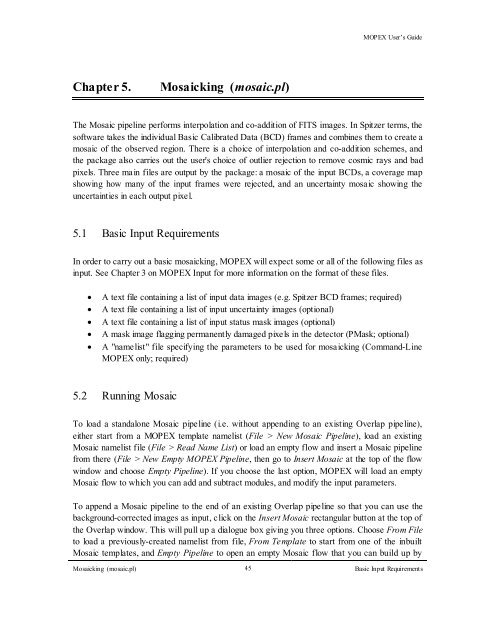Create successful ePaper yourself
Turn your PDF publications into a flip-book with our unique Google optimized e-Paper software.
Chapter 5. Mosaicking (mosaic.pl)<br />
<strong>MOPEX</strong> User’s <strong>Guide</strong><br />
The Mosaic pipeline performs interpolation and co-addition of FITS images. In Spitzer terms, the<br />
software takes the individual Basic Calibrated Data (BCD) frames and combines them to create a<br />
mosaic of the observed region. There is a choice of interpolation and co-addition schemes, and<br />
the package also carries out the user's choice of outlier rejection to remove cosmic rays and bad<br />
pixels. Three main files are output by the package: a mosaic of the input BCDs, a coverage map<br />
showing how many of the input frames were rejected, and an uncertainty mosaic showing the<br />
uncertainties in each output pixel.<br />
5.1 Basic Input Requirements<br />
In order to carry out a basic mosaicking, <strong>MOPEX</strong> will expect some or all of the following files as<br />
input. See Chapter 3 on <strong>MOPEX</strong> Input for more information on the format of these files.<br />
• A text file containing a list of input data images (e.g. Spitzer BCD frames; required)<br />
• A text file containing a list of input uncertainty images (optional)<br />
• A text file containing a list of input status mask images (optional)<br />
• A mask image flagging permanently damaged pixels in the detector (PMask; optional)<br />
• A "namelist" file specifying the parameters to be used for mosaicking (Command-Line<br />
<strong>MOPEX</strong> only; required)<br />
5.2 Running Mosaic<br />
To load a standalone Mosaic pipeline (i.e. without appending to an existing Overlap pipeline),<br />
either start from a <strong>MOPEX</strong> template namelist (File > New Mosaic Pipeline), load an existing<br />
Mosaic namelist file (File > Read Name List) or load an empty flow and insert a Mosaic pipeline<br />
from there (File > New Empty <strong>MOPEX</strong> Pipeline, then go to Insert Mosaic at the top of the flow<br />
window and choose Empty Pipeline). If you choose the last option, <strong>MOPEX</strong> will load an empty<br />
Mosaic flow to which you can add and subtract modules, and modify the input parameters.<br />
To append a Mosaic pipeline to the end of an existing Overlap pipeline so that you can use the<br />
background-corrected images as input, click on the Insert Mosaic rectangular button at the top of<br />
the Overlap window. This will pull up a dialogue box giving you three options. Choose From File<br />
to load a previously-created namelist from file, From Template to start from one of the inbuilt<br />
Mosaic templates, and Empty Pipeline to open an empty Mosaic flow that you can build up by<br />
Mosaicking (mosaic.pl) 45<br />
Basic Input Requirements





